Representative Bureaucracy
VerifiedAdded on 2023/06/03
|9
|2227
|89
AI Summary
This article discusses the concept of representative bureaucracy, its historical background, characteristics, levels of national governments, and impact of education. It also covers the positive and negative effects of bureaucracy, law enforcement, and the impact of education on representative bureaucracy.
Contribute Materials
Your contribution can guide someone’s learning journey. Share your
documents today.

Running head: REPRESENTATIVE BUREAUCRACY 1
Representative Bureaucracy
Student’s name
Institution affiliation
Representative Bureaucracy
Student’s name
Institution affiliation
Secure Best Marks with AI Grader
Need help grading? Try our AI Grader for instant feedback on your assignments.
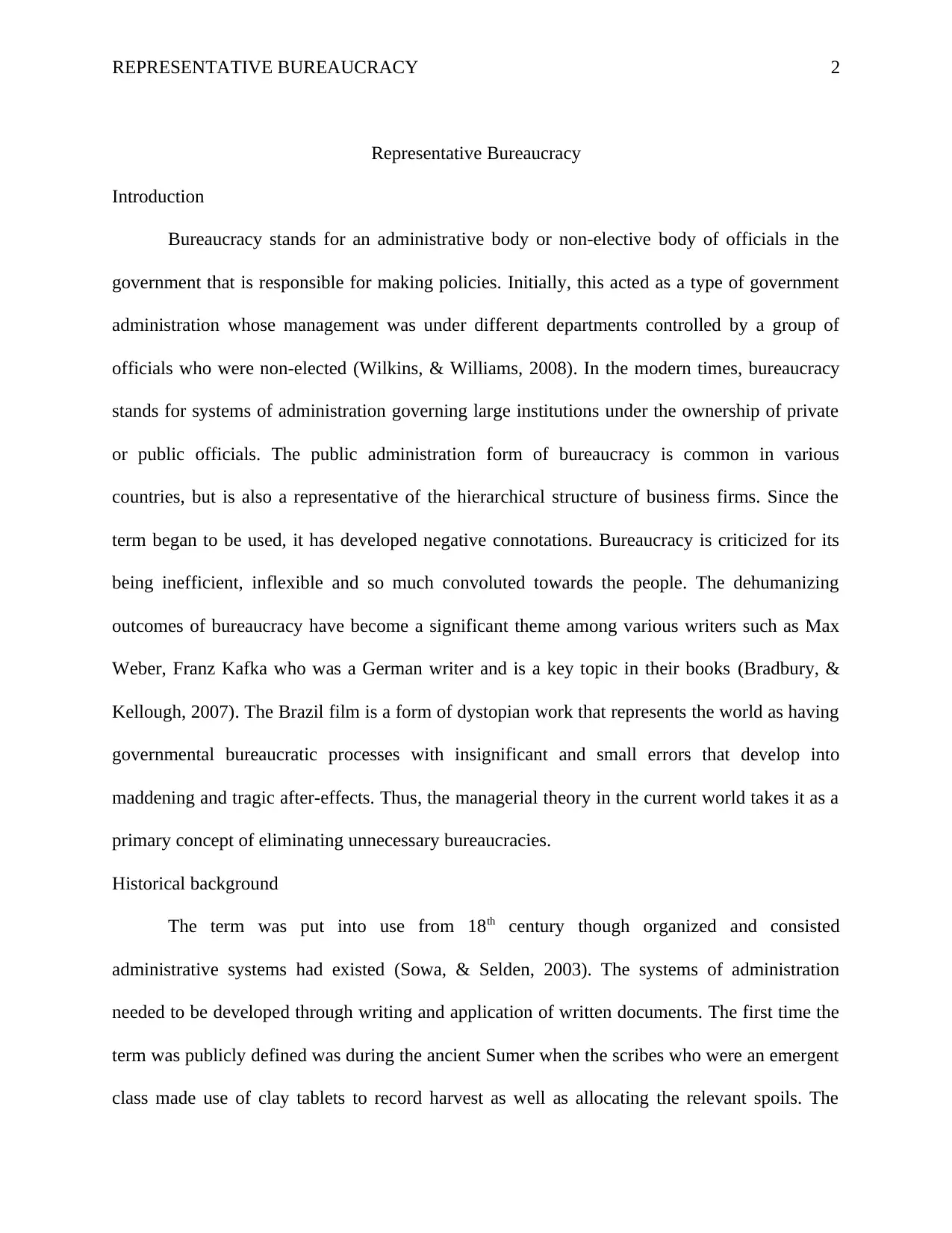
REPRESENTATIVE BUREAUCRACY 2
Representative Bureaucracy
Introduction
Bureaucracy stands for an administrative body or non-elective body of officials in the
government that is responsible for making policies. Initially, this acted as a type of government
administration whose management was under different departments controlled by a group of
officials who were non-elected (Wilkins, & Williams, 2008). In the modern times, bureaucracy
stands for systems of administration governing large institutions under the ownership of private
or public officials. The public administration form of bureaucracy is common in various
countries, but is also a representative of the hierarchical structure of business firms. Since the
term began to be used, it has developed negative connotations. Bureaucracy is criticized for its
being inefficient, inflexible and so much convoluted towards the people. The dehumanizing
outcomes of bureaucracy have become a significant theme among various writers such as Max
Weber, Franz Kafka who was a German writer and is a key topic in their books (Bradbury, &
Kellough, 2007). The Brazil film is a form of dystopian work that represents the world as having
governmental bureaucratic processes with insignificant and small errors that develop into
maddening and tragic after-effects. Thus, the managerial theory in the current world takes it as a
primary concept of eliminating unnecessary bureaucracies.
Historical background
The term was put into use from 18th century though organized and consisted
administrative systems had existed (Sowa, & Selden, 2003). The systems of administration
needed to be developed through writing and application of written documents. The first time the
term was publicly defined was during the ancient Sumer when the scribes who were an emergent
class made use of clay tablets to record harvest as well as allocating the relevant spoils. The
Representative Bureaucracy
Introduction
Bureaucracy stands for an administrative body or non-elective body of officials in the
government that is responsible for making policies. Initially, this acted as a type of government
administration whose management was under different departments controlled by a group of
officials who were non-elected (Wilkins, & Williams, 2008). In the modern times, bureaucracy
stands for systems of administration governing large institutions under the ownership of private
or public officials. The public administration form of bureaucracy is common in various
countries, but is also a representative of the hierarchical structure of business firms. Since the
term began to be used, it has developed negative connotations. Bureaucracy is criticized for its
being inefficient, inflexible and so much convoluted towards the people. The dehumanizing
outcomes of bureaucracy have become a significant theme among various writers such as Max
Weber, Franz Kafka who was a German writer and is a key topic in their books (Bradbury, &
Kellough, 2007). The Brazil film is a form of dystopian work that represents the world as having
governmental bureaucratic processes with insignificant and small errors that develop into
maddening and tragic after-effects. Thus, the managerial theory in the current world takes it as a
primary concept of eliminating unnecessary bureaucracies.
Historical background
The term was put into use from 18th century though organized and consisted
administrative systems had existed (Sowa, & Selden, 2003). The systems of administration
needed to be developed through writing and application of written documents. The first time the
term was publicly defined was during the ancient Sumer when the scribes who were an emergent
class made use of clay tablets to record harvest as well as allocating the relevant spoils. The
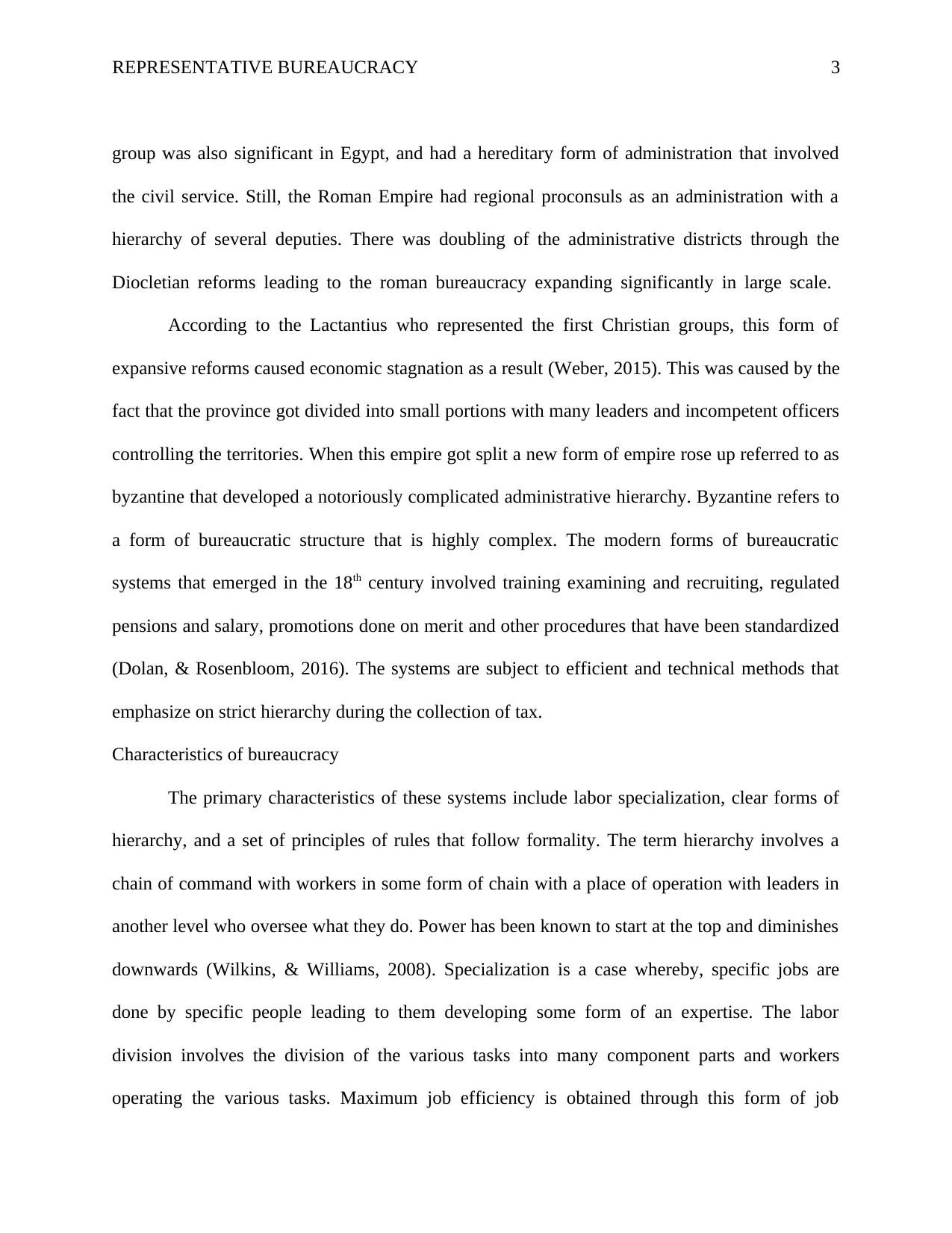
REPRESENTATIVE BUREAUCRACY 3
group was also significant in Egypt, and had a hereditary form of administration that involved
the civil service. Still, the Roman Empire had regional proconsuls as an administration with a
hierarchy of several deputies. There was doubling of the administrative districts through the
Diocletian reforms leading to the roman bureaucracy expanding significantly in large scale.
According to the Lactantius who represented the first Christian groups, this form of
expansive reforms caused economic stagnation as a result (Weber, 2015). This was caused by the
fact that the province got divided into small portions with many leaders and incompetent officers
controlling the territories. When this empire got split a new form of empire rose up referred to as
byzantine that developed a notoriously complicated administrative hierarchy. Byzantine refers to
a form of bureaucratic structure that is highly complex. The modern forms of bureaucratic
systems that emerged in the 18th century involved training examining and recruiting, regulated
pensions and salary, promotions done on merit and other procedures that have been standardized
(Dolan, & Rosenbloom, 2016). The systems are subject to efficient and technical methods that
emphasize on strict hierarchy during the collection of tax.
Characteristics of bureaucracy
The primary characteristics of these systems include labor specialization, clear forms of
hierarchy, and a set of principles of rules that follow formality. The term hierarchy involves a
chain of command with workers in some form of chain with a place of operation with leaders in
another level who oversee what they do. Power has been known to start at the top and diminishes
downwards (Wilkins, & Williams, 2008). Specialization is a case whereby, specific jobs are
done by specific people leading to them developing some form of an expertise. The labor
division involves the division of the various tasks into many component parts and workers
operating the various tasks. Maximum job efficiency is obtained through this form of job
group was also significant in Egypt, and had a hereditary form of administration that involved
the civil service. Still, the Roman Empire had regional proconsuls as an administration with a
hierarchy of several deputies. There was doubling of the administrative districts through the
Diocletian reforms leading to the roman bureaucracy expanding significantly in large scale.
According to the Lactantius who represented the first Christian groups, this form of
expansive reforms caused economic stagnation as a result (Weber, 2015). This was caused by the
fact that the province got divided into small portions with many leaders and incompetent officers
controlling the territories. When this empire got split a new form of empire rose up referred to as
byzantine that developed a notoriously complicated administrative hierarchy. Byzantine refers to
a form of bureaucratic structure that is highly complex. The modern forms of bureaucratic
systems that emerged in the 18th century involved training examining and recruiting, regulated
pensions and salary, promotions done on merit and other procedures that have been standardized
(Dolan, & Rosenbloom, 2016). The systems are subject to efficient and technical methods that
emphasize on strict hierarchy during the collection of tax.
Characteristics of bureaucracy
The primary characteristics of these systems include labor specialization, clear forms of
hierarchy, and a set of principles of rules that follow formality. The term hierarchy involves a
chain of command with workers in some form of chain with a place of operation with leaders in
another level who oversee what they do. Power has been known to start at the top and diminishes
downwards (Wilkins, & Williams, 2008). Specialization is a case whereby, specific jobs are
done by specific people leading to them developing some form of an expertise. The labor
division involves the division of the various tasks into many component parts and workers
operating the various tasks. Maximum job efficiency is obtained through this form of job
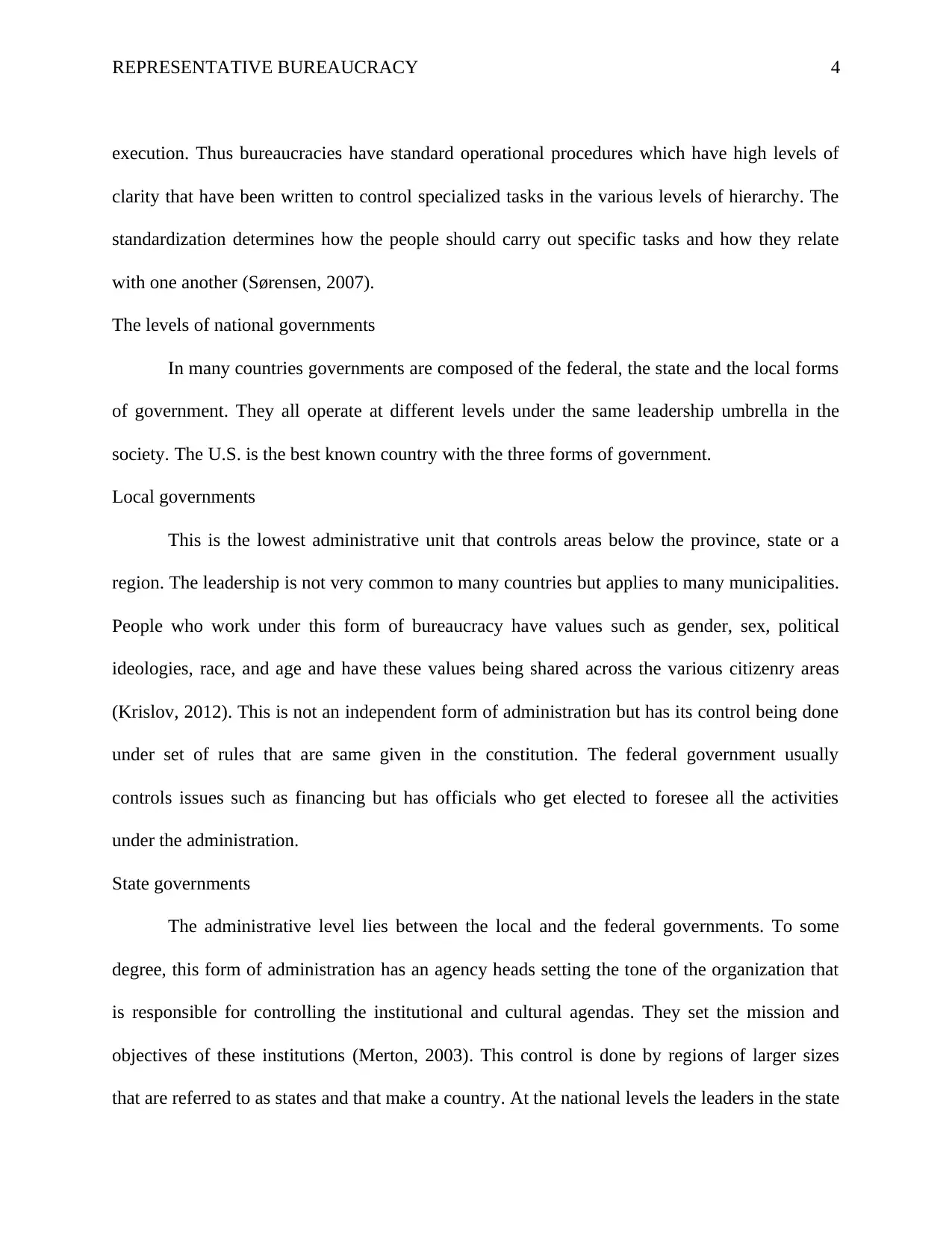
REPRESENTATIVE BUREAUCRACY 4
execution. Thus bureaucracies have standard operational procedures which have high levels of
clarity that have been written to control specialized tasks in the various levels of hierarchy. The
standardization determines how the people should carry out specific tasks and how they relate
with one another (Sørensen, 2007).
The levels of national governments
In many countries governments are composed of the federal, the state and the local forms
of government. They all operate at different levels under the same leadership umbrella in the
society. The U.S. is the best known country with the three forms of government.
Local governments
This is the lowest administrative unit that controls areas below the province, state or a
region. The leadership is not very common to many countries but applies to many municipalities.
People who work under this form of bureaucracy have values such as gender, sex, political
ideologies, race, and age and have these values being shared across the various citizenry areas
(Krislov, 2012). This is not an independent form of administration but has its control being done
under set of rules that are same given in the constitution. The federal government usually
controls issues such as financing but has officials who get elected to foresee all the activities
under the administration.
State governments
The administrative level lies between the local and the federal governments. To some
degree, this form of administration has an agency heads setting the tone of the organization that
is responsible for controlling the institutional and cultural agendas. They set the mission and
objectives of these institutions (Merton, 2003). This control is done by regions of larger sizes
that are referred to as states and that make a country. At the national levels the leaders in the state
execution. Thus bureaucracies have standard operational procedures which have high levels of
clarity that have been written to control specialized tasks in the various levels of hierarchy. The
standardization determines how the people should carry out specific tasks and how they relate
with one another (Sørensen, 2007).
The levels of national governments
In many countries governments are composed of the federal, the state and the local forms
of government. They all operate at different levels under the same leadership umbrella in the
society. The U.S. is the best known country with the three forms of government.
Local governments
This is the lowest administrative unit that controls areas below the province, state or a
region. The leadership is not very common to many countries but applies to many municipalities.
People who work under this form of bureaucracy have values such as gender, sex, political
ideologies, race, and age and have these values being shared across the various citizenry areas
(Krislov, 2012). This is not an independent form of administration but has its control being done
under set of rules that are same given in the constitution. The federal government usually
controls issues such as financing but has officials who get elected to foresee all the activities
under the administration.
State governments
The administrative level lies between the local and the federal governments. To some
degree, this form of administration has an agency heads setting the tone of the organization that
is responsible for controlling the institutional and cultural agendas. They set the mission and
objectives of these institutions (Merton, 2003). This control is done by regions of larger sizes
that are referred to as states and that make a country. At the national levels the leaders in the state
Paraphrase This Document
Need a fresh take? Get an instant paraphrase of this document with our AI Paraphraser
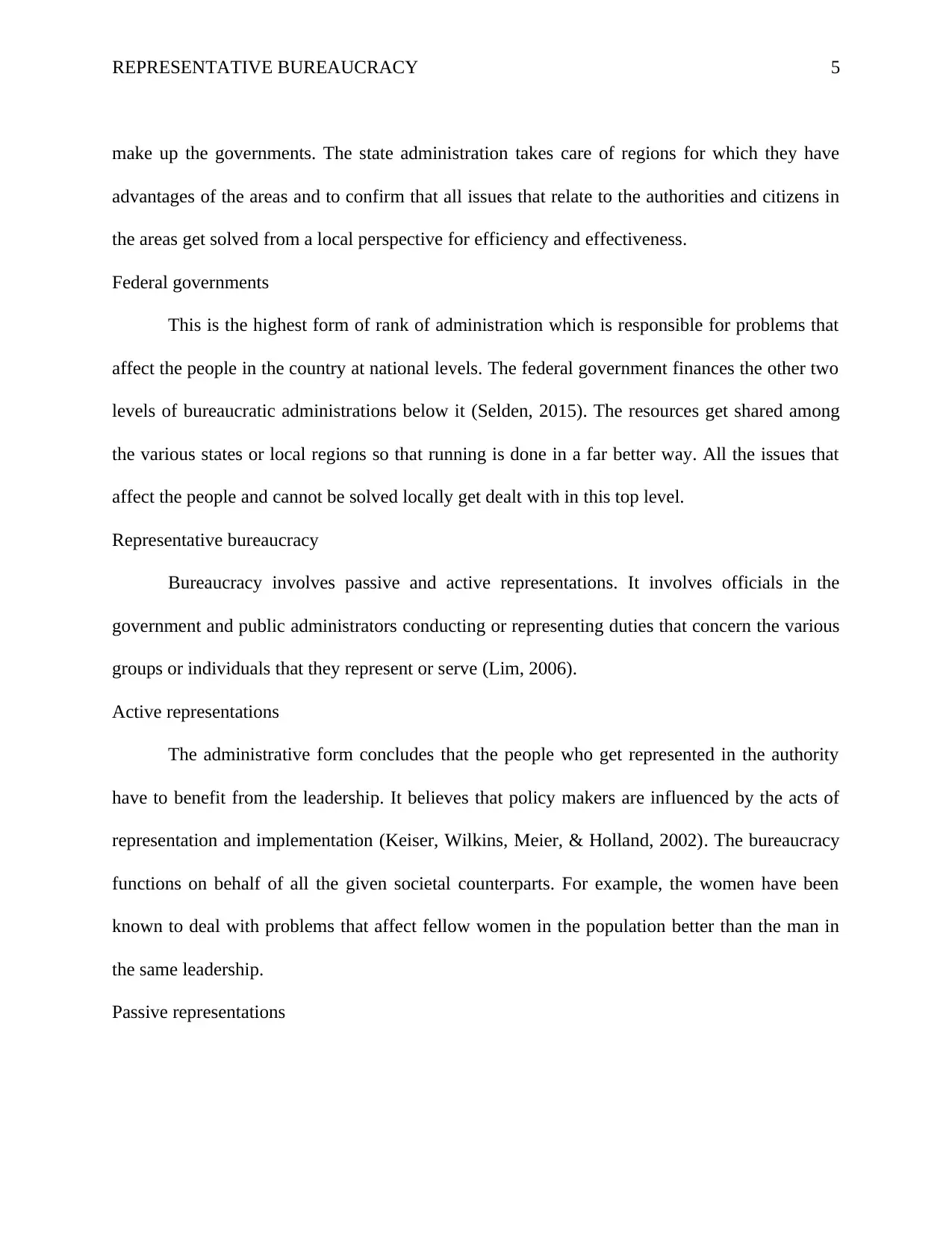
REPRESENTATIVE BUREAUCRACY 5
make up the governments. The state administration takes care of regions for which they have
advantages of the areas and to confirm that all issues that relate to the authorities and citizens in
the areas get solved from a local perspective for efficiency and effectiveness.
Federal governments
This is the highest form of rank of administration which is responsible for problems that
affect the people in the country at national levels. The federal government finances the other two
levels of bureaucratic administrations below it (Selden, 2015). The resources get shared among
the various states or local regions so that running is done in a far better way. All the issues that
affect the people and cannot be solved locally get dealt with in this top level.
Representative bureaucracy
Bureaucracy involves passive and active representations. It involves officials in the
government and public administrators conducting or representing duties that concern the various
groups or individuals that they represent or serve (Lim, 2006).
Active representations
The administrative form concludes that the people who get represented in the authority
have to benefit from the leadership. It believes that policy makers are influenced by the acts of
representation and implementation (Keiser, Wilkins, Meier, & Holland, 2002). The bureaucracy
functions on behalf of all the given societal counterparts. For example, the women have been
known to deal with problems that affect fellow women in the population better than the man in
the same leadership.
Passive representations
make up the governments. The state administration takes care of regions for which they have
advantages of the areas and to confirm that all issues that relate to the authorities and citizens in
the areas get solved from a local perspective for efficiency and effectiveness.
Federal governments
This is the highest form of rank of administration which is responsible for problems that
affect the people in the country at national levels. The federal government finances the other two
levels of bureaucratic administrations below it (Selden, 2015). The resources get shared among
the various states or local regions so that running is done in a far better way. All the issues that
affect the people and cannot be solved locally get dealt with in this top level.
Representative bureaucracy
Bureaucracy involves passive and active representations. It involves officials in the
government and public administrators conducting or representing duties that concern the various
groups or individuals that they represent or serve (Lim, 2006).
Active representations
The administrative form concludes that the people who get represented in the authority
have to benefit from the leadership. It believes that policy makers are influenced by the acts of
representation and implementation (Keiser, Wilkins, Meier, & Holland, 2002). The bureaucracy
functions on behalf of all the given societal counterparts. For example, the women have been
known to deal with problems that affect fellow women in the population better than the man in
the same leadership.
Passive representations
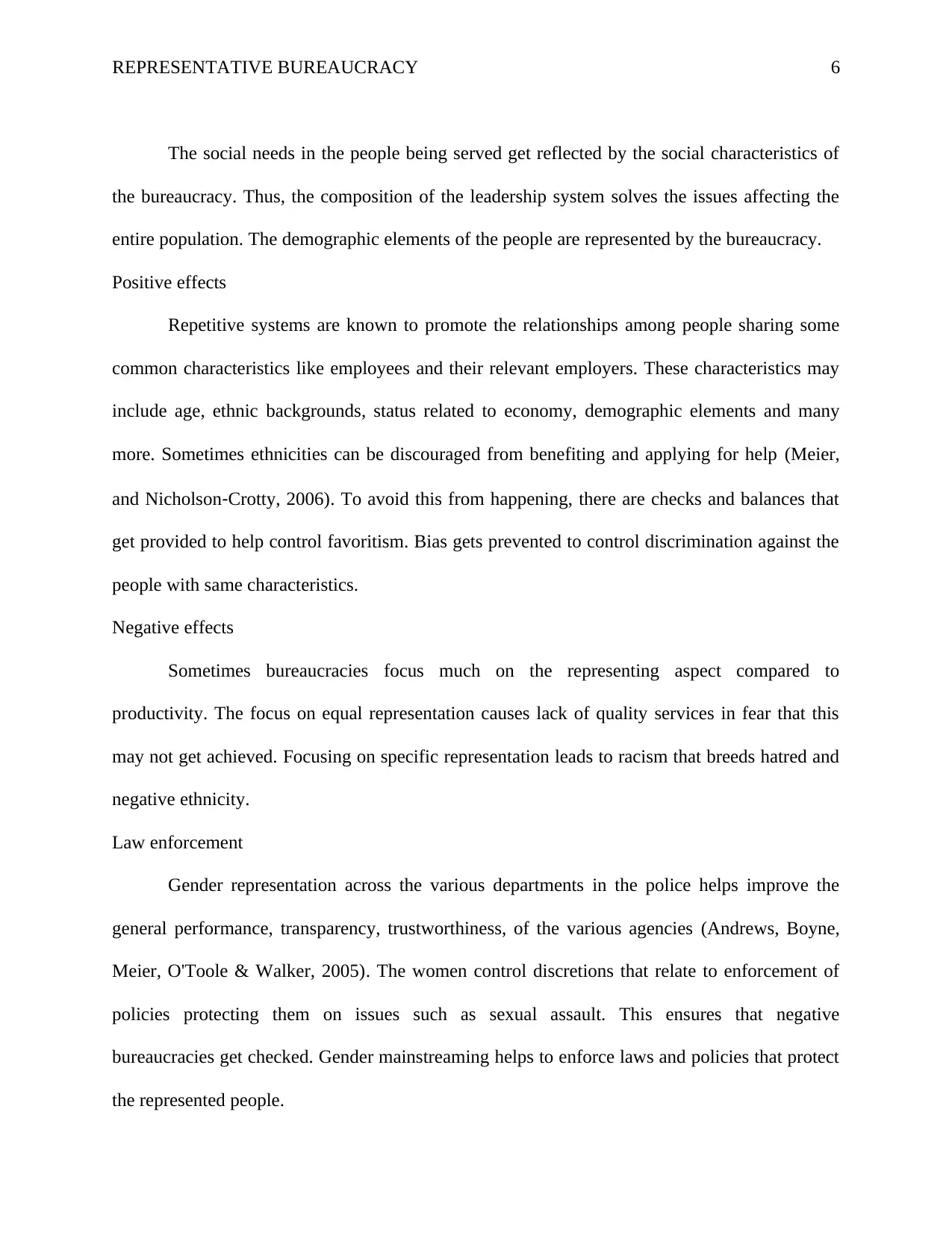
REPRESENTATIVE BUREAUCRACY 6
The social needs in the people being served get reflected by the social characteristics of
the bureaucracy. Thus, the composition of the leadership system solves the issues affecting the
entire population. The demographic elements of the people are represented by the bureaucracy.
Positive effects
Repetitive systems are known to promote the relationships among people sharing some
common characteristics like employees and their relevant employers. These characteristics may
include age, ethnic backgrounds, status related to economy, demographic elements and many
more. Sometimes ethnicities can be discouraged from benefiting and applying for help (Meier,
and Nicholson‐Crotty, 2006). To avoid this from happening, there are checks and balances that
get provided to help control favoritism. Bias gets prevented to control discrimination against the
people with same characteristics.
Negative effects
Sometimes bureaucracies focus much on the representing aspect compared to
productivity. The focus on equal representation causes lack of quality services in fear that this
may not get achieved. Focusing on specific representation leads to racism that breeds hatred and
negative ethnicity.
Law enforcement
Gender representation across the various departments in the police helps improve the
general performance, transparency, trustworthiness, of the various agencies (Andrews, Boyne,
Meier, O'Toole & Walker, 2005). The women control discretions that relate to enforcement of
policies protecting them on issues such as sexual assault. This ensures that negative
bureaucracies get checked. Gender mainstreaming helps to enforce laws and policies that protect
the represented people.
The social needs in the people being served get reflected by the social characteristics of
the bureaucracy. Thus, the composition of the leadership system solves the issues affecting the
entire population. The demographic elements of the people are represented by the bureaucracy.
Positive effects
Repetitive systems are known to promote the relationships among people sharing some
common characteristics like employees and their relevant employers. These characteristics may
include age, ethnic backgrounds, status related to economy, demographic elements and many
more. Sometimes ethnicities can be discouraged from benefiting and applying for help (Meier,
and Nicholson‐Crotty, 2006). To avoid this from happening, there are checks and balances that
get provided to help control favoritism. Bias gets prevented to control discrimination against the
people with same characteristics.
Negative effects
Sometimes bureaucracies focus much on the representing aspect compared to
productivity. The focus on equal representation causes lack of quality services in fear that this
may not get achieved. Focusing on specific representation leads to racism that breeds hatred and
negative ethnicity.
Law enforcement
Gender representation across the various departments in the police helps improve the
general performance, transparency, trustworthiness, of the various agencies (Andrews, Boyne,
Meier, O'Toole & Walker, 2005). The women control discretions that relate to enforcement of
policies protecting them on issues such as sexual assault. This ensures that negative
bureaucracies get checked. Gender mainstreaming helps to enforce laws and policies that protect
the represented people.
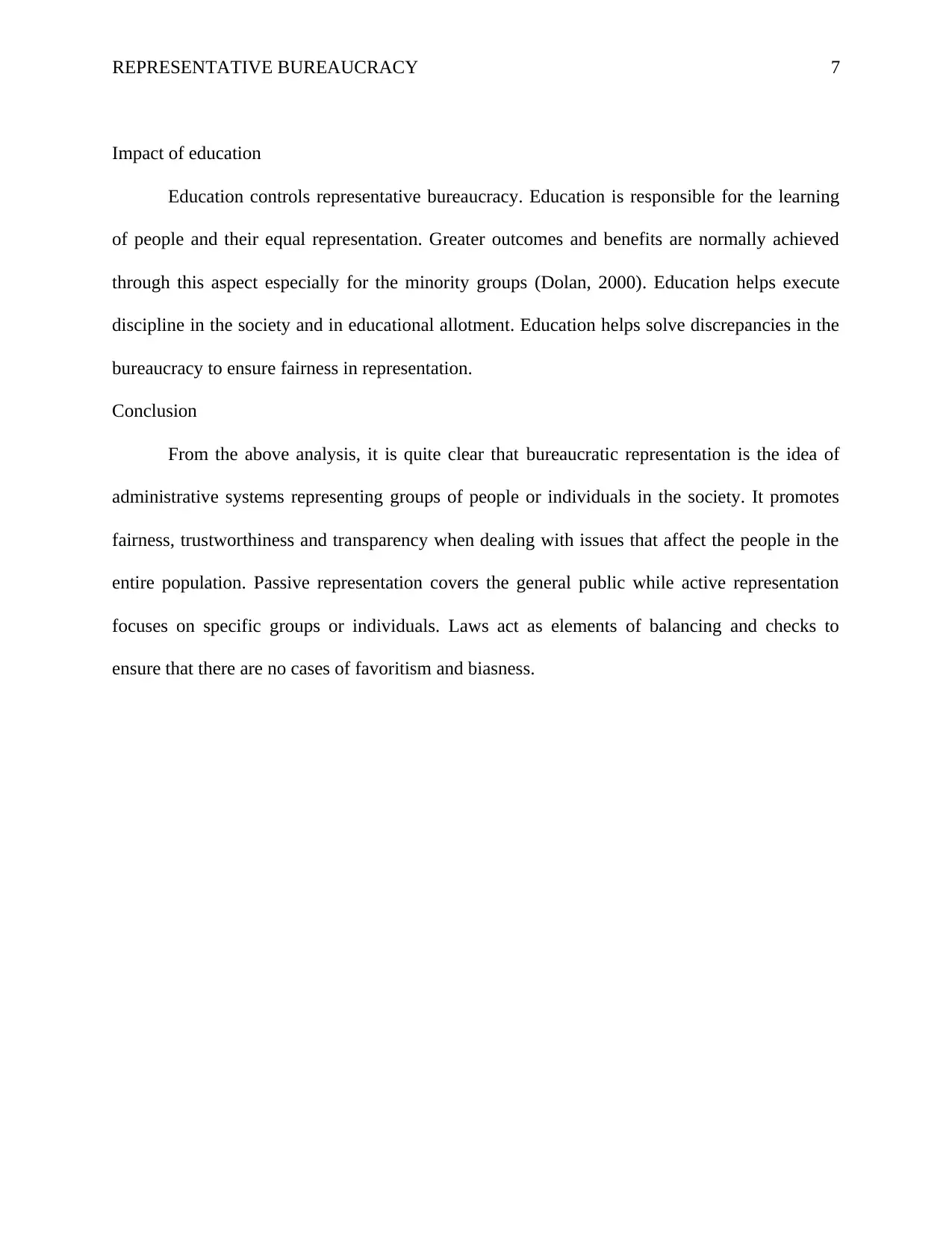
REPRESENTATIVE BUREAUCRACY 7
Impact of education
Education controls representative bureaucracy. Education is responsible for the learning
of people and their equal representation. Greater outcomes and benefits are normally achieved
through this aspect especially for the minority groups (Dolan, 2000). Education helps execute
discipline in the society and in educational allotment. Education helps solve discrepancies in the
bureaucracy to ensure fairness in representation.
Conclusion
From the above analysis, it is quite clear that bureaucratic representation is the idea of
administrative systems representing groups of people or individuals in the society. It promotes
fairness, trustworthiness and transparency when dealing with issues that affect the people in the
entire population. Passive representation covers the general public while active representation
focuses on specific groups or individuals. Laws act as elements of balancing and checks to
ensure that there are no cases of favoritism and biasness.
Impact of education
Education controls representative bureaucracy. Education is responsible for the learning
of people and their equal representation. Greater outcomes and benefits are normally achieved
through this aspect especially for the minority groups (Dolan, 2000). Education helps execute
discipline in the society and in educational allotment. Education helps solve discrepancies in the
bureaucracy to ensure fairness in representation.
Conclusion
From the above analysis, it is quite clear that bureaucratic representation is the idea of
administrative systems representing groups of people or individuals in the society. It promotes
fairness, trustworthiness and transparency when dealing with issues that affect the people in the
entire population. Passive representation covers the general public while active representation
focuses on specific groups or individuals. Laws act as elements of balancing and checks to
ensure that there are no cases of favoritism and biasness.
Secure Best Marks with AI Grader
Need help grading? Try our AI Grader for instant feedback on your assignments.
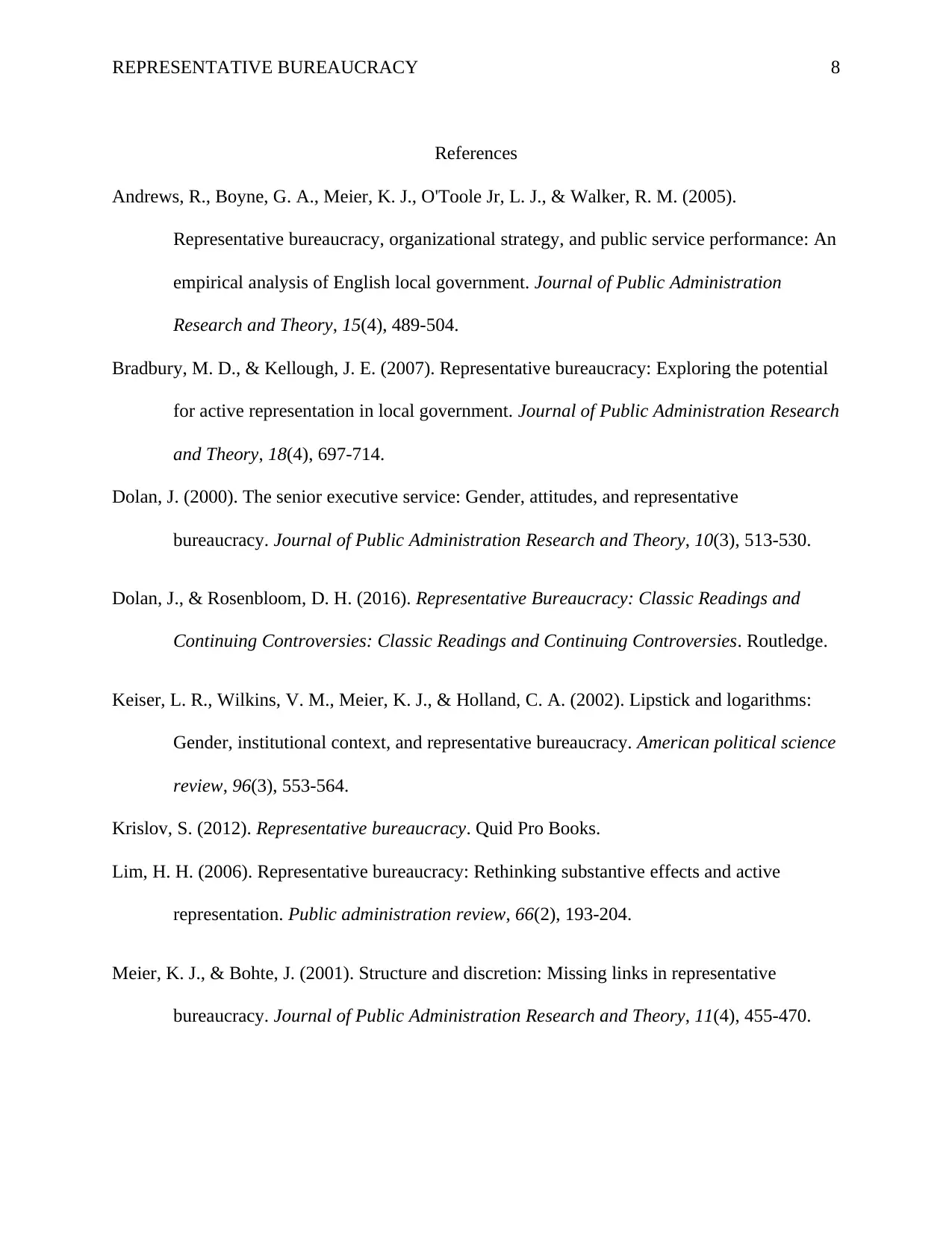
REPRESENTATIVE BUREAUCRACY 8
References
Andrews, R., Boyne, G. A., Meier, K. J., O'Toole Jr, L. J., & Walker, R. M. (2005).
Representative bureaucracy, organizational strategy, and public service performance: An
empirical analysis of English local government. Journal of Public Administration
Research and Theory, 15(4), 489-504.
Bradbury, M. D., & Kellough, J. E. (2007). Representative bureaucracy: Exploring the potential
for active representation in local government. Journal of Public Administration Research
and Theory, 18(4), 697-714.
Dolan, J. (2000). The senior executive service: Gender, attitudes, and representative
bureaucracy. Journal of Public Administration Research and Theory, 10(3), 513-530.
Dolan, J., & Rosenbloom, D. H. (2016). Representative Bureaucracy: Classic Readings and
Continuing Controversies: Classic Readings and Continuing Controversies. Routledge.
Keiser, L. R., Wilkins, V. M., Meier, K. J., & Holland, C. A. (2002). Lipstick and logarithms:
Gender, institutional context, and representative bureaucracy. American political science
review, 96(3), 553-564.
Krislov, S. (2012). Representative bureaucracy. Quid Pro Books.
Lim, H. H. (2006). Representative bureaucracy: Rethinking substantive effects and active
representation. Public administration review, 66(2), 193-204.
Meier, K. J., & Bohte, J. (2001). Structure and discretion: Missing links in representative
bureaucracy. Journal of Public Administration Research and Theory, 11(4), 455-470.
References
Andrews, R., Boyne, G. A., Meier, K. J., O'Toole Jr, L. J., & Walker, R. M. (2005).
Representative bureaucracy, organizational strategy, and public service performance: An
empirical analysis of English local government. Journal of Public Administration
Research and Theory, 15(4), 489-504.
Bradbury, M. D., & Kellough, J. E. (2007). Representative bureaucracy: Exploring the potential
for active representation in local government. Journal of Public Administration Research
and Theory, 18(4), 697-714.
Dolan, J. (2000). The senior executive service: Gender, attitudes, and representative
bureaucracy. Journal of Public Administration Research and Theory, 10(3), 513-530.
Dolan, J., & Rosenbloom, D. H. (2016). Representative Bureaucracy: Classic Readings and
Continuing Controversies: Classic Readings and Continuing Controversies. Routledge.
Keiser, L. R., Wilkins, V. M., Meier, K. J., & Holland, C. A. (2002). Lipstick and logarithms:
Gender, institutional context, and representative bureaucracy. American political science
review, 96(3), 553-564.
Krislov, S. (2012). Representative bureaucracy. Quid Pro Books.
Lim, H. H. (2006). Representative bureaucracy: Rethinking substantive effects and active
representation. Public administration review, 66(2), 193-204.
Meier, K. J., & Bohte, J. (2001). Structure and discretion: Missing links in representative
bureaucracy. Journal of Public Administration Research and Theory, 11(4), 455-470.
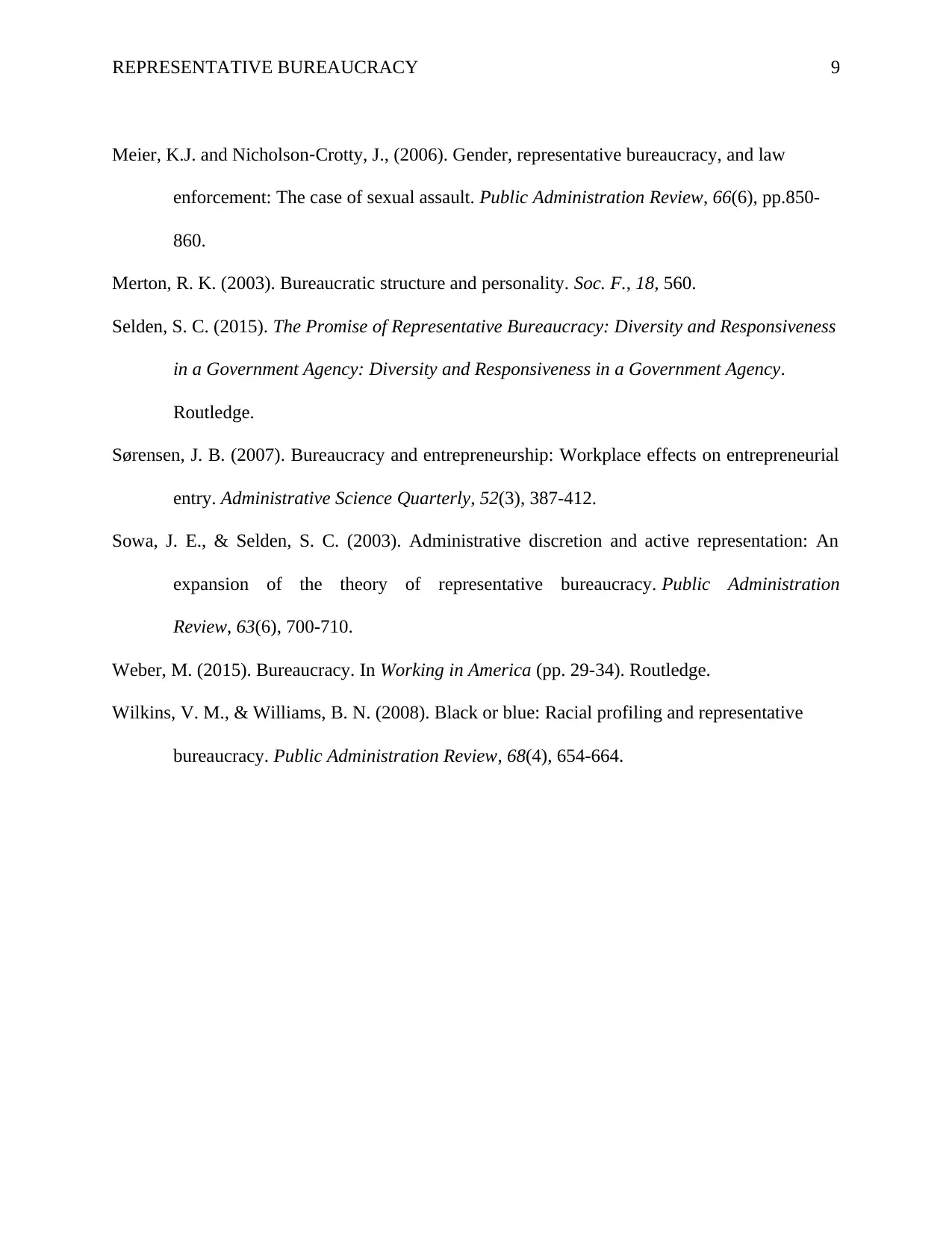
REPRESENTATIVE BUREAUCRACY 9
Meier, K.J. and Nicholson‐Crotty, J., (2006). Gender, representative bureaucracy, and law
enforcement: The case of sexual assault. Public Administration Review, 66(6), pp.850-
860.
Merton, R. K. (2003). Bureaucratic structure and personality. Soc. F., 18, 560.
Selden, S. C. (2015). The Promise of Representative Bureaucracy: Diversity and Responsiveness
in a Government Agency: Diversity and Responsiveness in a Government Agency.
Routledge.
Sørensen, J. B. (2007). Bureaucracy and entrepreneurship: Workplace effects on entrepreneurial
entry. Administrative Science Quarterly, 52(3), 387-412.
Sowa, J. E., & Selden, S. C. (2003). Administrative discretion and active representation: An
expansion of the theory of representative bureaucracy. Public Administration
Review, 63(6), 700-710.
Weber, M. (2015). Bureaucracy. In Working in America (pp. 29-34). Routledge.
Wilkins, V. M., & Williams, B. N. (2008). Black or blue: Racial profiling and representative
bureaucracy. Public Administration Review, 68(4), 654-664.
Meier, K.J. and Nicholson‐Crotty, J., (2006). Gender, representative bureaucracy, and law
enforcement: The case of sexual assault. Public Administration Review, 66(6), pp.850-
860.
Merton, R. K. (2003). Bureaucratic structure and personality. Soc. F., 18, 560.
Selden, S. C. (2015). The Promise of Representative Bureaucracy: Diversity and Responsiveness
in a Government Agency: Diversity and Responsiveness in a Government Agency.
Routledge.
Sørensen, J. B. (2007). Bureaucracy and entrepreneurship: Workplace effects on entrepreneurial
entry. Administrative Science Quarterly, 52(3), 387-412.
Sowa, J. E., & Selden, S. C. (2003). Administrative discretion and active representation: An
expansion of the theory of representative bureaucracy. Public Administration
Review, 63(6), 700-710.
Weber, M. (2015). Bureaucracy. In Working in America (pp. 29-34). Routledge.
Wilkins, V. M., & Williams, B. N. (2008). Black or blue: Racial profiling and representative
bureaucracy. Public Administration Review, 68(4), 654-664.
1 out of 9
![[object Object]](/_next/static/media/star-bottom.7253800d.svg)



